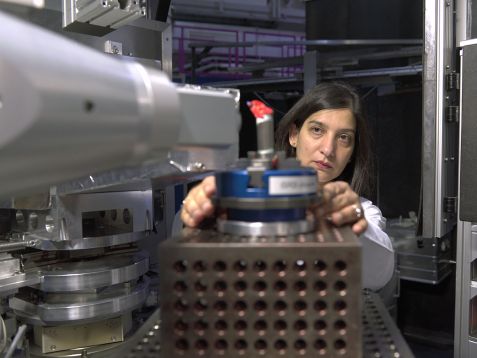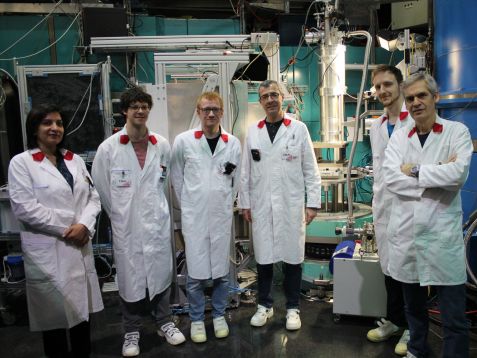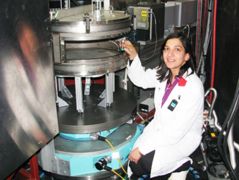MLZ is a cooperation between:
 > Technische Universität München
> Technische Universität München > Helmholtz-Zentrum Hereon
> Helmholtz-Zentrum Hereon
 > Forschungszentrum Jülich
> Forschungszentrum Jülich
MLZ is a member of:
 > LENS
> LENS > ERF-AISBL
> ERF-AISBL
MLZ on social media:

MLZ (eng)
Lichtenbergstr.1
85748 Garching
04.02.2020
More battery, more energy revolution

Dr. Neelima Paul adjusts the battery to be tested on the instrument STRESS-SPEC © Wenzel Schürmann/ TUM
Batteries with an anode of carbon and silicon store more energy than anodes of pure carbon. This makes them highly interesting for the energy revolution. In order to increase their efficiency in future, researchers from Ulm investigated the batteries with neutrons at the MLZ and discovered a new ageing mechanism that distinguishes them from pure graphite anodes.
In cooperation with researchers from the Center for Solar Energy and Hydrogen Research in Ulm (ZSW), the research group led by Dr. Ralph Gilles from the MLZ investigated the carbon-silicon anode (C/Si anode) with neutrons. This anode is promising because it stores more energy than conventional anodes for the same coating thickness. Electric cars could travel longer distances with one charge and wind power could be stored more efficiently.
“To produce batteries that last longer and store more energy, we need to understand their aging process,” says Dr. Thomas Waldmann of ZSW.
Cold makes old
In general, a battery that is being charged ages faster in cold conditions than at room temperature. For the neutron experiment at the STRESS-SPEC measuring instrument, the team, together with instrument scientist Dr. Michael Hofmann, subjected the battery to an artificial ageing process. They cooled it down to minus temperatures, charged it and observed the processes in the battery while it returned to its state of equilibrium (relaxation process).
Neutrons reveal ageing process

The team performing the experiments at the instrument STRESS-SPEC (from left to right): Dr. Neelima Paul (TUM), Nicola Jobst (ZSW), Dr. Thomas Waldmann (ZSW), Dr. Rares-George Scurtu (ZSW), Karsten Richter (ZSW), Dr. Ralph Gilles (TUM) © Michael Hofmann/ TUM
While the battery is charging, the lithium ions from the electrolyte liquid accumulate in the framework of the anode (lithiation). During a slow charge, carbon and silicon are lithiated equally.
For the experiment, the researchers increased the charging speed. At first, it is primarily the carbon that incorporates the lithium ions, later they are also incorporated in the silicon. In addition, lithium precipitates in the form of metallic deposits on the anode, where it reacts with electrolyte on its surface. As a result, some of it is no longer available for the battery. The battery ages.
After the charging process is completed, the relaxation phase begins. The researchers observed two processes. On the one hand, some metallic lithium was intercalated in the graphite (and probably also in the silicon) during the initial relaxation.The second observation is even more interesting. In the later relaxation phase the lithium is redistributed. It partly dissolves from the graphite and forms a compound with silicon.
This means that the aging process in C/Si anodes proceeds differently than in pure graphite anodes. This has now been proven for the first time by neutron measurements.
View into the inside of the battery
In a crystalline atomic structure, neutrons can show how the lithium ions are embedded (lithiation). Pure graphite and lithiated graphite are crystalline. However, as soon as lithium forms a compound with silicon, it no longer appears in the measurement results. This is because lithiated silicon has an irregular (amorphous) atomic structure.
“So in order to reveal the new aging mechanism, we drew conclusions from the measured lithiated graphite reflexes,” says Dr. Neelima Paul.
For the scientists, the results are a signpost to a future battery generation that may also influence the energy turnaround. In order to build batteries with higher storage capacity and longer life, they will continue to research the mechanisms in C/Si anodes.
Original Publication
K. Richter, T. Waldmann, N. Paul, N. Jobst, R.-G. Scurtu, M. Hofmann, R. Gilles, M. Wohlfahrt-Mehrens, Low-Temperature Charging and Aging Mechanisms of Si/C Composite Anodes in Li-Ion Batteries – An Operando Neutron Scattering Study, ChemSusChem, 2019, DOI: https://onlinelibrary.wiley.com/doi/abs/10.1002/cssc.201903139
Related News
MLZ is a cooperation between:
 > Technische Universität München
> Technische Universität München > Helmholtz-Zentrum Hereon
> Helmholtz-Zentrum Hereon
 > Forschungszentrum Jülich
> Forschungszentrum Jülich
MLZ is a member of:
 > LENS
> LENS > ERF-AISBL
> ERF-AISBL
MLZ on social media:



